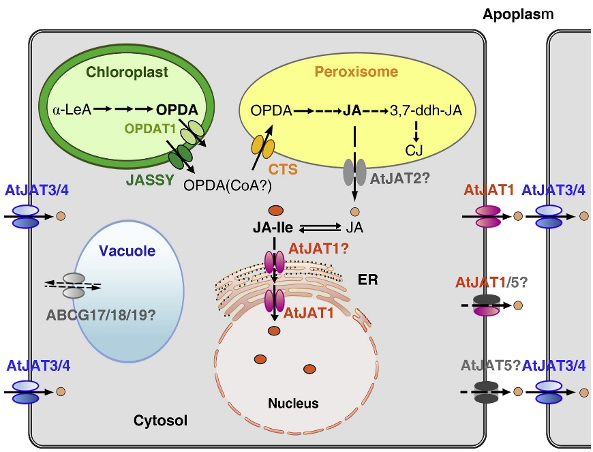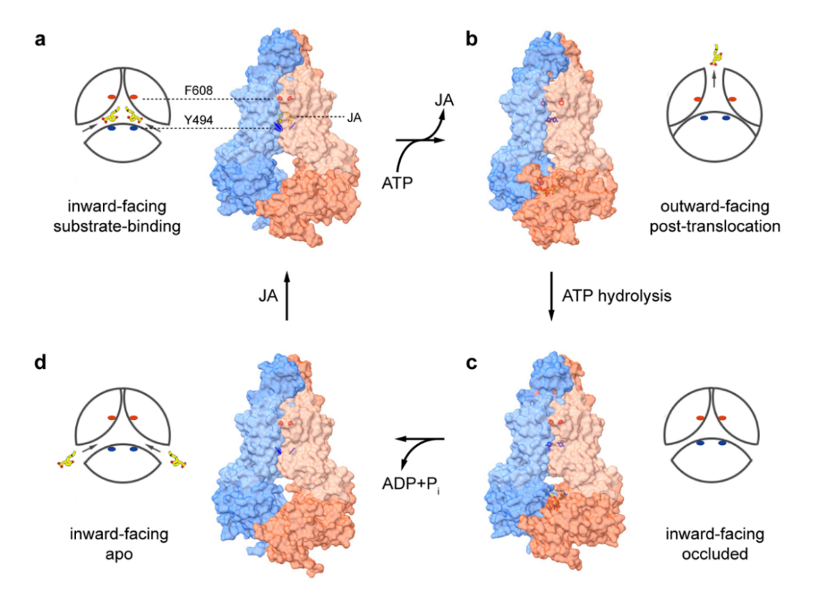Peng Zhang's group reveals the molecular mechanism of the jasmonic acid transporter ABCG16
On November 4th 2024, Professor Peng Zhang's group from the Center of Excellence for Molecular Plant Sciences, Chinese Academy of Sciences, published an article entitled “Cryo-EM structure and molecular mechanism of the jasmonic acid transporter ABCG16” in the international academic journal Nature Plants. The study reveals the molecular mechanism by which ABCG16 specifically recognizes and transports jasmonic acid.
As a crucial plant hormone, jasmonic acid (JA) plays an essential role not only in the defense responses of plants to biotic and abiotic stresses but also in regulating plant growth and development. JA is a derivative of fatty acids, and its synthesis initiates in the chloroplasts of plants, with subsequent synthesis, modification, and metabolism taking place in organelles such as peroxisomes and vacuoles before being transported to the cell nucleus to exert physiological effects. Transporters are pivotal in the transmembrane transport of JA and its precursors and derivatives (Figure 1). In Arabidopsis, ABCG16/JAT1 is an ABC family transporter localized to the plasma and nuclear membranes. Research indicates that AtABCG16 can mediate the translocation of JA 1, and it has also been found to be involved in the translocation of abscisic acid (ABA) 2. In short, the molecular processes of how JA is specifically recognized and transported by transporters during transmembrane transport remain unknown.

Figure 1. Transporter-mediated intra- and intercellular transport of JAs 3.
In this study, researchers utilized the Xenopus oocyte transport system to demonstrate that AtABCG16 is an effective exporter of JA, but not ABA. By heterologous expression, protein purification, and the use of various ATP analogs, the researchers captured different states of the AtABCG16 during translocation in vitro. They employed single-particle cryo-EM to determine the three-dimensional structures of AtABCG16 in inward-facing apo (AtABCG16inward-apo), JA-bound (AtABCG16inward-JA) and occluded conformations (AtABCG16occluded), and outward-facing post translocation conformation (AtABCG16outward) (Figure 2).

Figure 2. Overall structures of AtABCG16.
Structural analysis has revealed the homodimeric structure of AtABCG16, the binding site for JA, and the key residues that determine substrate-specific binding (Figure 3). The role of these residues in JA binding and transport was confirmed using the Xenopus oocyte transport system and Arabidopsis stress treatment experiments. Further analysis found that the substrate-binding pocket of AtABCG16 is unable to accommodate ABA, thereby explaining why it cannot mediate the transport of ABA.

Figure 3. Specific JA-binding of AtABCG16.
Researchers, by comparing the different conformations of AtABCG16, discovered that it has two independent substrate entrances on the cytoplasmic side, each leading to their respective substrate-binding pockets and connected to the translocation pathway formed by the dimer. Two aromatic amino acids, Y494 and F608, are located at the substrate entrances and within the transmembrane pathway, respectively, controlling their opening and closing (Figure 4). This unique structural feature determines that the translocation mechanism of AtABCG16 is distinctly different from that of other known ABC transporters. Based on structural and biochemical analysis, researchers have proposed a working model for the JA transport mediated by AtABCG16.
This study not only uncovers the molecular mechanism by which AtABCG16 specifically recognizes and transports JA across the membrane, resolving disputes regarding the substrate transport by AtABCG16, but also diversifies the translocation mechanism of ABC transporters.

Figure 4. Substrate translocation model of AtABCG16.
Ning An (Ph.D. candidate from the Center of Excellence for Molecular Plant Sciences, CAS) and Dr. Xiaowei Huang (Ph.D. graduate in 2023) are the co-first authors of this paper; Prof. Peng Zhang and Dr. Xue Zhang (Assistant Professor) are the co-corresponding authors. The Xenopus oocyte transport experiment was greatly assisted by the Yong-Fei Wang’s group from the institute. The collection of electron microscopy data and the analysis of protein/substrate samples were supported and assisted by Fudan University, the CAS Interdisciplinary Research Center on Biology and Chemistry, Shandong University, and the core facility center of CEMPS, CAS. This work was supported by grants from the National Natural Science Foundation of China and the Chinese Academy of Sciences.
Article link: https://www.nature.com/articles/s41477-024-01839-0
Reference
1. Li, Q. Q. et al. Transporter-mediated nuclear entry of jasmonoyl-isoleucine is essential for jasmonate signaling. Mol.Plant 10, 695-708 (2017).
2. Zhou, Y., Wang, Y., Zhang, D. & Liang, J. Endomembrane-biased dimerization of ABCG16 and ABCG25 transporters determines their substrate selectivity in ABA-regulated plant growth and stress responses. Mol. Plant 17, 478-495 (2024).
3. Li, M. Y., Yu, G. H., Cao, C. L. & Liu, P. Metabolism, signaling, and transport of jasmonates. Plant Commun. 2, 100231 (2021).